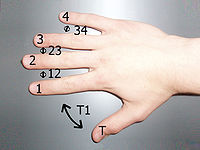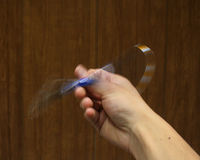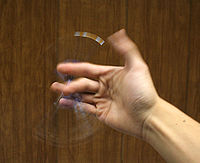
Pen spinning
Encyclopedia
.gif)
Object manipulation
Object manipulation is a form of dexterity play or performance in which one or more artists physically interact with one or more objects. These can be special props made for the purpose of the manipulation itself - such as balls, clubs, hoops, rings, poi, staff, devil sticks, etc. - or any other...
that involves the deft manipulation of a writing instrument with one's hands. Although it is often considered a form of self-entertainment (usually in a school/office setting), multinational competitions and meetings are sometimes held. It is a form of contact juggling
Contact juggling
Contact juggling is a form of object manipulation that focuses on the movement of objects such as balls in contact with the body. Although often used in conjunction with "toss juggling", it differs in that it involves the rolling of one or more objects without releasing them into the air...
.
It can also be classified as a sport.
Pen spinning is known as "pen mawashi" (compare for example mawashi-geri, "round-kick") or, more disparagingly, "rōnin mawashi" "college student spinning" in Japan where the pastime has been popular since at least the 1970s, and where the Pen Spinning Association Japan is now dedicated to promoting the aspiring art form. While its origins remain unclear, pen-spinning is quickly gaining international popularity through on-line video sharing and forums. According to Masaki Tsukada, chairman of the Japanese pen spinners, pen spinning now has dedicated movements in South Korea and the United States.
History
There is no information on the origins of pen spinning. The earliest record of pen spinning comes from a student in pre-World War II in Japan (Asahi Shimbun January 31, 2008, 37th page). While some in Asian countries did pen spinning in the 1990s, these were basic tricks such asthe Thumbaround, FingerPass, Charge, and Sonic. Today, there are more variations and types of tricks, for example the Shadow, the Bak, the Twisted Sonic Bust or the PalmSpin.
The number of pen spinning websites and forums have increased since 2006, opening up more regional boards from France, Germany, Taiwan
Taiwan
Taiwan , also known, especially in the past, as Formosa , is the largest island of the same-named island group of East Asia in the western Pacific Ocean and located off the southeastern coast of mainland China. The island forms over 99% of the current territory of the Republic of China following...
, Japan, and Korea. Tournaments are organised on the Internet and live tournaments are held in Japan and Korea.
Finger Slots, Notations and Breakdowns
Spinners use a variety of systems, symbols, abbreviations and short forms to help them express how the pen is spun.Finger Slot System

Index finger
The index finger, , is the first finger and the second digit of a human hand. It is located between the first and third digits, between the thumb and the middle finger...
, to "4" pinky. The thumb
Thumb
The thumb is the first digit of the hand. When a person is standing in the medical anatomical position , the thumb is the lateral-most digit...
is the letter "T". Finger slots are represented by combining any two of these. For instance the space between the middle
Middle finger
The middle finger or long finger is the third digit of the human hand, located between the index finger and the ring finger. It is usually the longest finger...
and ring finger
Ring finger
The ring finger is the fourth digit of the human hand, and the second most ulnar finger, located between the middle finger and the little finger. It is also called digitus medicinalis, the fourth finger, digitus annularis, digitus quartus, or digitus IV in anatomy.- Etymology :According to László A...
s is "23". A pen held between index and pinky is in slot "14". Sometimes the space between the thumb and index fingers near the palm is called "TF" (thumbflap) and the slot of the tips of the thumb at the index finger is called "T1". The palm is sometimes notated as "P".
Notations
The notation system consists of a combination of abbreviations and short forms of tricks and their direction slot system to define the direction and position of a trick. Words that define direction/how the move is preformed are usually shortened. The 3 words that get shortened are "reverse" to "rev", "inverse" to "inv or sometimes in" and "fingerless" to "fl", the shortened versions are sometimes followed by a period/".". (Eg.reverse sonic is changed to rev. sonic and inverse shadow is changed to inv. shadow.)Names of tricks are sometimes shortened or abbreviated. Tricks such as Twisted sonic, Index Pinky Bak Around and Thumbaround are examples of such tricks. Twisted sonic will be come "TWS" or "TW sonic". Index Pinky Bak Around will become "IDPBA" and Thumbaround will become "TA".
Breakdowns
Breakdowns are annotations of links(a mix of a few tricks) and combos (combinations of links) which are used to define how a link or combo is preformed. When moves are defined on where it is preformed, spinners use the finger slots to help them, they write the trick first then the slot it starts at and a "-" after and finish with the slot the trick ends at(Eg. Sonic 23-12). When writing breakdowns, spinners usually follow two standard structures. The 1st structure is normally Direction (Rev) then "how"(Inv, FL), then the trick name then the slots it is in (Eg. Rev Inv Sonic 12-23). The 2nd structure is similar to the 1st one however, the "how" is written first, then the trick name is written, then the abbreviated notations and then the slots (Eg. Inv Sonic Rev 12-23). Following these structures are not really necessary, it is just a guideline on how to write breakdowns, so most spinners write it in a different but similar ways.Fundamental tricks
In Pen Spinning there are 4 main fundamental tricks spinners should learn first. They are as follows.ThumbAround

FingerPass
The "Pass" involves spinning the pen through the fingers. A combination of Passes are called FingerPasses.The FingerPass was used in the James Bond
James Bond
James Bond, code name 007, is a fictional character created in 1953 by writer Ian Fleming, who featured him in twelve novels and two short story collections. There have been a six other authors who wrote authorised Bond novels or novelizations after Fleming's death in 1964: Kingsley Amis,...
film GoldenEye
GoldenEye
GoldenEye is the seventeenth spy film in the James Bond series, and the first to star Pierce Brosnan as the fictional MI6 agent James Bond. The film was directed by Martin Campbell and is the first film in the series not to take story elements from the works of novelist Ian Fleming...
by Boris Grishenko, in a variation using only three fingers instead of the usual four.
Sonic

Charge
The Charge does not involve spinning the pen around any fingers or any body parts, rather, the pen is manipulated in such a way with two fingers, that it seems to spin in a very fast motion, in a conic-shaped path. Its conic path and its speed thus create an illusion of the charging motion of the pen. This trick is often performed by drummers using drumsticks rather than pens. It looks like the pen is spinning in the two fingers. Right-handed people performing this trick would mean that the pen is revolving clockwise. If it is going the opposite direction, it is called Charge Reverse.Advanced Tricks
In addition to the 4 fundamental tricks, more have been invented and used successfully in combos by numerous people.Infinity
The pen should begin by being held in the writing position, near the tip of a pen. A wiper reverse is performed, where the pen pivots from the top of the thumb and index finger to the bottom of the thumb and index finger. A pass to the index/middle fingers is then performed. The pen pivots from the top of these fingers to the bottom. The pen is then swung back up to the writing position. When the pen is not passed to a different finger slot, the trick is called "Figure 8". When more passes are involved, the trick may be called other names such as "Double Infinity".Shadow
This is a trick where the palm is facing down. The pen starts at any finger slot (usually 12) and does 0.5 rotations in the charge position before traveling up to the top of the hand. The pen should revolve 0.5 times on top of your fingers. As it nears the end of the 0.5 revolutions on top, slowly lift any of your fingers to catch the pen (usually the index finger to catch it in the 12 slot). At the end, a final 0.5 revolutions of charge should end the trick.Inverse Shadow
If the Shadow is performed with the palm of the hand facing up, the trick is called the Inverse Shadow and is much more difficult to master than the Shadow.ThumbSpin
The ThumbSpin is a variation of the ThumbAround, except it spins more than one revolution and spins on top of the thumb. The starting and ending positions are the same as the ThumbAround and the spinner can make the pen spin as many revolutions as they would like.Korean BackAround
The Korean BackAround, or simply "Bak", is a popular trick where the pen goes around any of the four fingers that are not the thumb. It is basically a Fingerless FingerAround Reverse, except follows a diagonal motion when spinning. A Bak that goes around the index finger would be called the Index Bak. A popular mini combo executed by pen spinners is called the BakFall (Korean BackAround Fall), where the spinner executes four Baks, connected by Passes, starting from the index finger and making their way down to the pinky.Hai Tua
The Hai Tua is a trick that involves the pen spinning around the hand. The breakdown of the Hai Tua is a twisted sonic to Thumbaround or fingerless Thumbaround to a HandAround to a Fingerless Thumbaround Catch. The trick begins with the twisted sonic to Thumbaround or fingerless Thumbaround, but instead of catching the pen, the spinner turns their palm down so that the pen continues to spin, gliding over the back side of the hand. The pen moves to the end of the hand and is released into the air for a very short amount of time. The spinner then turns their palm back up to catch the pen as they would with a Fingerless Thumbaround.The Hai Tua makes 2.5 revolutions. The Hai Tua is not a beginner trick and should be avoided by newer spinners.

